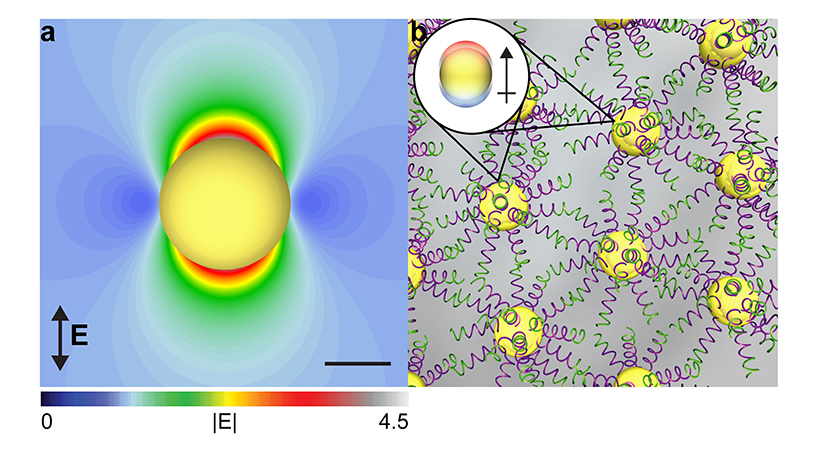DNA enables one to precisely place nanoparticles into periodic structures (called “superlattices”) in two or three dimensions as either large films or near-perfect single crystals. By constructing the superlattices from gold nanoparticles, a Northwestern University research group, carrying out studies at the U.S. Department of Energy’s Advanced Photon Source (APS), reported in Nature Nanotechnology that they can precisely control how light flows though and interacts with these materials. Control over nanoparticle arrangement, crystal size, and crystal shape provides a way for making new types of optical materials.
The interdisciplinary team of researchers utilized detailed x-ray measurements obtained at DuPont-Northwestern-Dow Collaborative Access Team (DND-CAT) beamline 5-ID-B,C,D and the X-ray Science Division (XSD) beamline 12-ID-B, both at the APS (which is an Office of Science user facility) to explore the structural properties of nanoparticle superlattices that intimately control light-matter interactions.
A major advantage of using nanoparticles to build new materials is that their properties can change depending on how they are arranged. Here, the researchers demonstrated that by carefully controlling how the nanoparticles are positioned across multiple length scales, their optical response can be rationally designed to absorb or scatter light.
Structural measurements at the APS provided detailed information about the symmetry and spacing of the nanoparticles in the superlattices, which influences their optical properties. Theoretical results by the same team last year reported that by independently changing the spacing between nanoparticles in addition to the larger-scale crystal shape, one could control how light flows through the superlattices. The modification of nanoparticles with DNA allows them to act as “programmable atom equivalents” that can be assembled into over 30 different crystal symmetries. This control, combined with the recent advance enabling the synthesis of large single crystals, provided a means for testing these theoretical predictions. Small-angle x-ray scattering measurements performed at the DND-CAT beamline and grazing incidence small-angle x-ray scattering studies at the XSD beamline provided detailed information about the crystalline nanoparticle arrangement, which ultimately dictates their properties.
These results advance the scientific community’s understanding of what happens to nanoparticles as one arranges them into larger, more complex structures with well-defined shapes. In the future, the research team aims to incorporate new types of nanoparticles, including other metals, semiconductors such as quantum dots that fluoresce, and metal oxides with unusual magnetic or catalytic properties. The team is excited about using superlattice crystalline materials for photonic and energy applications that require the precise control over light flow and confinement, for example in new classes of batteries and photovoltaics.
See: Michael B. Ross, Jessie C. Ku, Victoria M. Vaccarezza, George C. Schatz**, and Chad A. Mirkin*, “Nanoscale form dictates mesoscale function in plasmonic DNA–nanoparticle superlattices,” Nat. Nano. 10, 453 (May 2015). DOI: 10.1038/NNANO.2015.68
Author affiliation: Northwestern University
Correspondence: * [email protected], ** [email protected]
This research was supported by an Air Force Office of Scientific Research Multidisciplinary University Research Initiative grant (FA9550-11-1-0275), by the Northwestern Materials Research Center (U.S. National Science Foundation [NSF] grant DMR-1121262), and by the Center for Bio-Inspired Energy Science, an Energy Frontier Research Center funded by the U.S. Department of Energy (DOE) Office of Science-Basic Energy Sciences under award DE-SC0000989-0002. M.B.R. and J.C.K. acknowledge support from the National Defense Science and Engineering Graduate Fellowship program. This work made use of the EPIC facility (NUANCE Center-Northwestern University), which has received support from the Materials Research Science and Engineering Centers program (NSF DMR-1121262) at the Materials Research Center, the International Institute for Nanotechnology; and the State of Illinois, through the International Institute for Nanotechnology. DND-CAT is supported by Northwestern University, E.I. DuPont de Nemours & Co., and The Dow Chemical Company. This research used resources of the Advanced Photon Source, a U.S. Department of Energy (DOE) Office of Science User Facility operated for the DOE Office of Science by Argonne National Laboratory under Contract No. DE-AC02-06CH11357.
Argonne National Laboratory is supported by the Office of Science of the U.S. Department of Energy. The Office of Science is the single largest supporter of basic research in the physical sciences in the United States, and is working to address some of the most pressing challenges of our time. For more information, please visit science.energy.gov.

